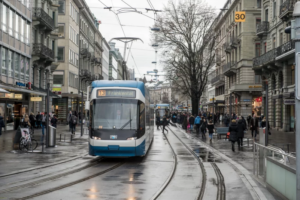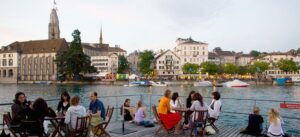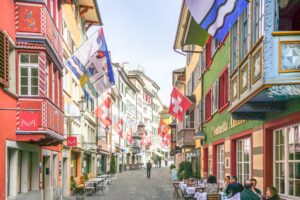Some Facts about Zurich.

.
Zurich is the largest city in Switzerland and the capital of the canton of Zürich.
It is located in north-central Switzerland at the northwestern tip of Lake Zürich. The municipality has approx 400,028 inhabitants, and the Zurich metropolitan area 1.83 million.
Zürich is a hub for railways, roads, and air traffic. Both Zürich Airport and railway station are the largest and busiest in the country.
Working in Zurich
Zürich is a leading global city and among the world’s largest financial centers.The city is home to a large number of financial institutions and banking giants. Most of Switzerland’s research and development centers are concentrated in Zürich and the low tax rates attract overseas companies to set up their headquarters there.
Monocle’s 2012 “Quality of Life Survey” ranked Zürich first on a list of the top 25 cities in the world “to make a base within”.According to several surveys from 2006 to 2008, Zürich was named the city with the best quality of life in the world as well as the wealthiest city in Europe.
The Governing of Zurich
The City Council (Stadtrat) constitutes the executive government of the City of Zürich and operates as a collegiate authority. It is composed of nine councilors, each presiding over a department. The president of the executive department acts as mayor. Current city president is Corine Mauch. Departmental tasks, coordination measures and implementation of laws decreed by the City Parliament are carried by the City Council. The election of the City Council by registered voters is held every four years. The executive body holds its meetings in the City Hall, on the bank of the Limmat.

Around Zurich
On its west side the Limmat valley is flanked by the wooded heights of the Albis chain, which runs along the western border. The Uetliberg is 869 m (2,851 ft) above sea level, the highest elevation of the surrounding area. Its summit can be reached easily by the Uetlibergbahn. From the platform of the observation tower on the summit, an impressive panorama of the city, the lake and the Alps can be seen.
The areas surrounding the Limmat are almost completely improved with residential, industrial, and commercial zones. The sunny and desirable residential areas in the hills overlooking Zürich, Waidberg and Zürichberg, and the bottom part of the slope on the western side of the valley on the Üetliberg, are also densely built.
The “green lungs” of the city include the vast forest areas of Adlisberg, Zürichberg, Käferberg, Hönggerberg and Üetliberg. Major parks are also located along the lakeshore (Zürichhorn and Enge), while smaller parks dot the city. Larger contiguous agricultural lands are located near Affoltern and Seebach.

Getting around Zurich
Public transport is extremely popular in Zürich, and its inhabitants use public transport in large numbers. Many of the visitors to the city use the tram or bus, and about half of the journeys within the municipality take place on public transport.
Within Zürich and throughout the canton of Zürich, the ZVV network of public transport has traffic density ratings among the highest worldwide.
The 4 main means of transport in Zurich are: The S-Bahn trains, trams, buses and boat
S-Bahn trains; Zürich HB is the largest and busiest station in Switzerland and is an important railway hub in Europe. There are between 350,000 and 500,000 commuters daily
Trams, like trains are unbeievably reliable with regular updates on times at every stop.
Buses, both diesel and electric also called trolley buses.
The Zürichsee-Schifffahrtsgesellschaft Ferry (commonly abbreviated to ZSG) operates passenger vessels on the Limmat River and the Lake Zürich, connecting surrounding towns between Zürich and Rapperswil.
In addition, the public transport network includes; funicular railways and even the Luftseilbahn Adliswil-Felsenegg (LAF), a cable car between Adliswil and Felsenegg. Tickets purchased for a trip are valid on all means of public transportation (train, tram, bus, boat).


